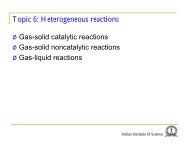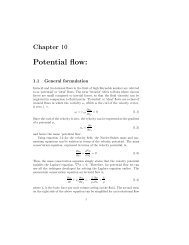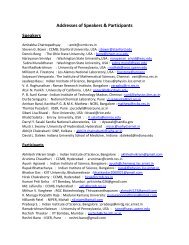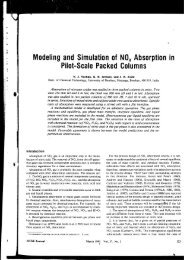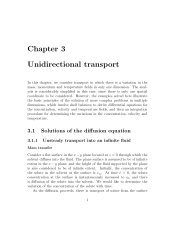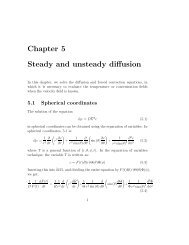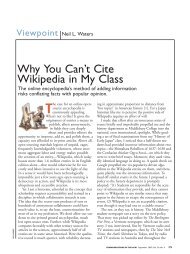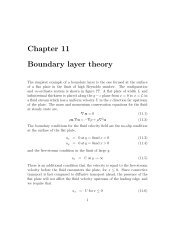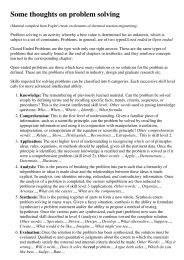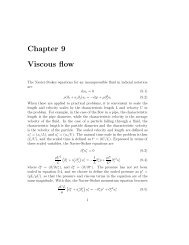Review The metabolism, pharmacokinetics and mechanisms of ...
Review The metabolism, pharmacokinetics and mechanisms of ...
Review The metabolism, pharmacokinetics and mechanisms of ...
Create successful ePaper yourself
Turn your PDF publications into a flip-book with our unique Google optimized e-Paper software.
Cell. Mol. Life Sci. Vol. 63, 2006 <strong>Review</strong> Article 833(a)NN NRiboseOwith ribavirin following 24 weeks <strong>of</strong> st<strong>and</strong>ard interferontherapy [14]. Following 48 weeks <strong>of</strong> interferon therapy,SVR increased from ~13% without to ~38% with ribavirin[14]. With pegylated interferon, which has betterpharmacokinetic properties than st<strong>and</strong>ard interferon, responserates improved further [18–20]. For instance, following48 weeks <strong>of</strong> therapy, SVR increased from ~29%without to ~56% with ribavirin [20].No alternative therapies exist for nonresponders [21, 22].Development <strong>of</strong> new anti-HCV drugs has been severelyimpeded by the lack <strong>of</strong> small animal models <strong>and</strong> efficientculture systems, <strong>and</strong> concern over the inherent ability <strong>of</strong>HCV to rapidly acquire antiviral drug resistance mutations[21, 22]. Consequently, combination therapy withpegylated interferon <strong>and</strong> ribavirin has become the currentst<strong>and</strong>ard <strong>of</strong> treatment for HCV infection [18]. At the sametime, significant efforts are under way to identify bettertreatment strategies that would improve long-term responserates [21–23]. <strong>The</strong> substantial improvements intreatment response rates induced by ribavirin suggest,promisingly, that tuning ribavirin therapy may improveresponse rates further. Maintenance therapy with ribavirinis already being assessed as an option for nonresponders[24].Rational therapy optimization hinges on a fundamentalunderst<strong>and</strong>ing <strong>of</strong> the antiviral role <strong>of</strong> ribavirin. Remarkably,despite the widespread use <strong>of</strong> ribavirin over the pastdecade, the predominant mechanism(s) <strong>of</strong> action <strong>of</strong> ribavirinare yet to be established [9, 25, 26]. <strong>The</strong> pharmacokineticpr<strong>of</strong>ile <strong>of</strong> ribavirin has a long terminal eliminationphase, which remains poorly understood [27]. <strong>The</strong>cause(s) <strong>of</strong> the synergy between interferon <strong>and</strong> ribavirin,which appears crucial in anti-HCV therapy [28], remainunclear. Notwithst<strong>and</strong>ing, the promise <strong>of</strong> improving therapyfor HCV infection has rekindled interest in ribavirin.Recent studies have made significant advances, unravelingvarious aspects <strong>of</strong> the effects <strong>of</strong> ribavirin on viralpathogenesis <strong>and</strong> treatment response. In this review, weexamine the current status <strong>of</strong> our underst<strong>and</strong>ing <strong>of</strong> ribavirin<strong>and</strong> its role in the treatment <strong>of</strong> HCV infection.Mechanisms <strong>of</strong> actionNH 2HCV is a hepatotropic flavivirus with a single linear positivestr<strong>and</strong> RNA genome <strong>of</strong> ~10 4 nucleotides. <strong>The</strong> mainNON NRiboseNHNH 2Figure 1. <strong>The</strong> chemical structures <strong>of</strong> ribavirin (a) <strong>and</strong> guanosine (b).(b)target <strong>of</strong> HCV is the hepatocyte. <strong>The</strong> HCV lifecycle remainsto be fully elucidated; most <strong>of</strong> the present underst<strong>and</strong>ingis from replicon systems <strong>and</strong> related viruses [see29–31]. HCV replication proceeds entirely in the cytoplasmin association with cytoplasmic membranes. Followingentry into hepatocytes, the positive str<strong>and</strong> RNAgenome is translated into viral proteins that include theRNA-dependent RNA polymerase (RdRp) central to thereplication process. RdRp employs the RNA genome as atemplate to form negative str<strong>and</strong> RNA intermediates,which in turn facilitate the formation <strong>of</strong> progeny positivestr<strong>and</strong> RNA genomes. <strong>The</strong> latter genomes are packagedinto new viral particles <strong>and</strong> released from infected hepatocytesinto circulation.HCV is a noncytopathic virus. Each infected hepatocytemay therefore give rise to a large number <strong>of</strong> progeny virionsduring its lifetime. Interferon is thought to act as anantiviral agent against HCV by inhibiting viral productionfrom infected hepatocytes [17, 32]. It does this indirectlyby inducing a large number <strong>of</strong> host cell genes thatestablish a non-specific antiviral state within an infectedhepatocyte that may affect viral protein synthesis <strong>and</strong> viralRNA stability [17]. In addition, interferon may actagainst HCV via its effects on the immune system, viz.,promotion <strong>of</strong> memory T-cell proliferation, natural killer(NK) cell activation, dendritic cell maturation <strong>and</strong> inhibition<strong>of</strong> T-cell apoptosis [17]. <strong>The</strong> result is a dramatic reductionin plasma HCV RNA following the onset <strong>of</strong> interferontherapy, which culminates in SVR in a smallfraction <strong>of</strong> the patients treated [33].Several <strong>mechanisms</strong> have been suggested for the broadspectrum antiviral activity <strong>of</strong> ribavirin, viz., direct inhibition<strong>of</strong> viral RNA replication, inhibition <strong>of</strong> the enzymeinosine-monophospate-dehydrogenase (IMPDH), immunomodulation,<strong>and</strong> mutagenesis [17, 25, 26, 34]. <strong>The</strong>se<strong>mechanisms</strong> are illustrated in Fig. 2. Ribavirin has alsobeen suggested to act synergistically with interferon [35,36]. Experimental evidence suggests that different combinations<strong>of</strong> these <strong>mechanisms</strong> may be at play against differentviruses. Here, we summarize available evidence foreach <strong>of</strong> these possible <strong>mechanisms</strong>.Direct inhibition <strong>of</strong> RNA replicationRibavirin is phosphorylated inside cells to ribavirinmono-, di- <strong>and</strong> triphosphate (RMP, RDP <strong>and</strong> RTP, respectively)[37]. RTP, a guanosine triphosphate (GTP)analog, is incorporated into replicating RNA str<strong>and</strong>s byviral RNA polymerases [37–40]. This erroneous incorporationmay inhibit chain elongation <strong>and</strong>, in the extremesituation, cause chain termination. Crotty et al. [38]showed that ribavirin was incorporated in nascent poliovirusstr<strong>and</strong>s without causing chain termination <strong>and</strong>that ribavirin paired equally efficiently with both cytidine<strong>and</strong> uridine. However, cytidine <strong>and</strong> uridine incorporation



